編輯:關於Android編程
本文實例講述了Android編程開發實現帶進度條和百分比的多線程下載。分享給大家供大家參考,具體如下:
繼上一篇《java多線程下載實例詳解》之後,可以將它移植到我們的安卓中來,下面是具體實現源碼:
DownActivity.java:
package com.example.downloads;
import java.io.File;
import java.io.IOException;
import java.io.RandomAccessFile;
import java.net.HttpURLConnection;
import java.net.MalformedURLException;
import java.net.URL;
import com.example.downloads.utils.DownLoadThread;
import android.os.Bundle;
import android.os.Environment;
import android.os.Handler;
import android.os.Message;
import android.annotation.SuppressLint;
import android.app.Activity;
import android.text.TextUtils;
import android.view.Menu;
import android.view.View;
import android.widget.EditText;
import android.widget.ProgressBar;
import android.widget.TextView;
import android.widget.Toast;
public class DownActivity extends Activity {
// 聲明控件
// 路徑與線程數量
public EditText et_url, et_num;
// 進度條
public static ProgressBar pb_thread;
// 顯示進度的操作
public TextView tv_pb;
// 線程的數量
public static int threadNum = 3;
// 每個線程負責下載的大小
public int blockSize;
public static int threadCount;// 數量
// 訪問的path
public String path;
public static boolean flag = true;
// 記錄進度條的值
public static int pb_count = 0;
public static Handler handler;
public static final int TEXTVALUE = 1;
public static int pb_num = 0;
public static int size = 0;
@Override
protected void onCreate(Bundle savedInstanceState) {
super.onCreate(savedInstanceState);
setContentView(R.layout.activity_down);
et_url = (EditText) findViewById(R.id.et_path);
et_num = (EditText) findViewById(R.id.et_threadNum);
pb_thread = (ProgressBar) findViewById(R.id.pb_down);
tv_pb = (TextView) findViewById(R.id.tv_pb);
handler = new Handler() {
@SuppressLint("HandlerLeak")
@Override
public void handleMessage(Message msg) {
super.handleMessage(msg);
switch (msg.what) {
case TEXTVALUE:
System.out.println("-------" + DownActivity.pb_count
+ "//////" + DownActivity.size);
// 改變TEXTView
pb_num = (DownActivity.pb_count * 100) / DownActivity.size;
tv_pb.setText("當前進度是+" + pb_num + "%");
break;
default:
break;
}
}
};
}
@Override
public boolean onCreateOptionsMenu(Menu menu) {
// Inflate the menu; this adds items to the action bar if it is present.
getMenuInflater().inflate(R.menu.main, menu);
return true;
}
public void downLoad(View v) {
DownActivity.flag = true;
DownActivity.pb_count = 0;
path = et_url.getText().toString();
String threadNum_et = et_num.getText().toString();
if (TextUtils.isEmpty(path) || TextUtils.isEmpty(threadNum_et)) {
Toast.makeText(this, "不能為空", Toast.LENGTH_LONG).show();
return;
}
Toast.makeText(this, "url:" + path + "--" + threadNum_et,
Toast.LENGTH_LONG).show();
// 轉換成數字
threadNum = Integer.valueOf(threadNum_et);
new Thread(new Runnable() {
@Override
public void run() {
try {
// 創建出URL對象
URL url = new URL(path);
// 創建出 HttpURLConnection對象
HttpURLConnection httpURLConnection = (HttpURLConnection) url
.openConnection();
// 設置 發請求發送的方式
httpURLConnection.setRequestMethod("GET");
// 設置請求是否超時時間
httpURLConnection.setConnectTimeout(5000);
// 設置
httpURLConnection
.setRequestProperty("User-Agent",
" Mozilla/5.0 (compatible; MSIE 10.0; Windows NT 6.2; Trident/6.0)");
// 是否響應成功
if (httpURLConnection.getResponseCode() == 200) {
// 獲取文件的大小
size = httpURLConnection.getContentLength();
System.out.println("文件的大小" + size);
// 設置進度條的最大值
pb_thread.setMax(size);
// 創建文件 //保存到SD卡上
// 首先判斷是否擁有sdcard
if (Environment.getExternalStorageState().equals(
Environment.MEDIA_MOUNTED)) {
// 獲取sdCard文件目錄對象
File sdFile = Environment
.getExternalStorageDirectory();
// 創建文件對象
File file = new File(sdFile, "youdao.exe");
RandomAccessFile accessFile = new RandomAccessFile(
file, "rwd");
// 設置文件的大小
accessFile.setLength(size);
// 每個線程下載的大小
blockSize = size / threadNum;
// 開三個線程 操作此文件
for (int i = 1; i <= threadNum; i++) {
// 1 2 3
// 計算出每個線程開始的位置
int startSize = (i - 1) * blockSize;
// 結束位置
int endSize = (i) * blockSize;
// 當線程是最後一個線程的時候
if (i == threadNum) {
// 判斷文件的大小是否大於計算出來的結束位置
if (size > endSize) {
// 結束位置 等於 文件的大小
endSize = size;
}
}
// 為每個線程創建一個隨機的讀取
RandomAccessFile threadAccessFile = new RandomAccessFile(
file, "rwd");
new Thread(new DownLoadThread(i,
threadAccessFile, startSize, endSize,
path)).start();
}
}
}
} catch (MalformedURLException e) {
e.printStackTrace();
} catch (IOException e) {
e.printStackTrace();
}
}
}).start();
}
/**
* 暫停操作
*
* @param v
*/
public void downPause(View v) {
Toast.makeText(this, "暫停", Toast.LENGTH_LONG).show();
this.flag = false;
}
}
DownLoadThread.java:
package com.example.downloads.utils;
import java.io.File;
import java.io.FileInputStream;
import java.io.FileOutputStream;
import java.io.IOException;
import java.io.InputStream;
import java.io.RandomAccessFile;
import java.net.HttpURLConnection;
import java.net.MalformedURLException;
import java.net.URL;
import com.example.downloads.DownActivity;
import android.os.Environment;
public class DownLoadThread implements Runnable {
public RandomAccessFile accessFile; // 每個線程 都擁有一個accessFile的文件對象 線程1 線程2 線程3
// 線程下載文件的起始位置
public int startSize;
public int endSize;
// 文件下載的path路徑
public String path;
public int threadId; // 線程的標識
public DownLoadThread(int threadId, RandomAccessFile accessFile,
int startSize, int endSize, String path) {
this.threadId = threadId;
this.accessFile = accessFile;
this.startSize = startSize;
this.endSize = endSize;
this.path = path;
}
@Override
public void run() {
// 執行run方法
try {
// 創建文件到SD卡上去
// 首先判斷是否擁有sdcard
if (Environment.getExternalStorageState().equals(
Environment.MEDIA_MOUNTED)) {
// 獲取sdCard文件目錄對象
File sdFile = Environment.getExternalStorageDirectory();
File threadFile = new File(sdFile, threadId + ".txt");
if (threadFile.exists()) {
// 讀取該文件的內容
// 創建文件的輸入流對象
FileInputStream fis = new FileInputStream(threadFile);
// 采用工具類讀取
byte data[] = StreamTools.isToData(fis);
// 轉化成字符串
String threadLen = new String(data);
if ((threadLen != null) && (!"".equals(threadLen))) {
startSize = Integer.valueOf(threadLen);
// 解決 416bug的錯誤
if (startSize > endSize) {
startSize = endSize - 1;
}
}
}
// 創建文件
// 創建URL對象
URL url = new URL(path);
// 創建HttpURLConnection對象
HttpURLConnection httpURLConnection = (HttpURLConnection) url
.openConnection();
// 設置請求的頭
httpURLConnection.setRequestMethod("GET");
// 設置請求是否超時時間
httpURLConnection.setConnectTimeout(5000);
// 設置
httpURLConnection
.setRequestProperty("User-Agent",
" Mozilla/5.0 (compatible; MSIE 10.0; Windows NT 6.2; Trident/6.0)");
// 關鍵的設置
httpURLConnection.setRequestProperty("Range", "bytes="
+ startSize + "-" + endSize);
// 輸出當前線程
System.out.println("當前線程" + threadId + " 下載開始位置:" + startSize
+ " 下載結束位置:" + endSize);
// 響應成功
// 設置隨機讀取文件的 開始位置
accessFile.seek(startSize);
// 獲取相應流對象
InputStream is = httpURLConnection.getInputStream();
// 創建輸出流對象
byte buffer[] = new byte[1024];
int len = 0;
int threadTotal = 0;// 每個線程下載後保存記錄 /
while ((len = is.read(buffer)) != -1) {
accessFile.write(buffer, 0, len);
threadTotal += len;// 記錄你寫入的長度 //xml文件
//改變進度條:
setProgressBar(len);
// 通過文件記錄文件下載的長度
FileOutputStream fos = new FileOutputStream(threadFile);
fos.write((threadTotal + "").getBytes());
fos.flush();
fos.close();
//發送handler消息
DownActivity.handler.sendEmptyMessage(DownActivity.TEXTVALUE);
if(!DownActivity.flag){
return;
}
}
accessFile.close();
is.close();
System.out.println(threadId + "線程執行完畢");
// 線程操作
synchronized (DownActivity.class) {
DownActivity.threadCount++;
if (DownActivity.threadCount >= DownActivity.threadNum) {
for (int i = 1; i <= DownActivity.threadNum; i++) {
// 獲取sdCard上的文件
File deleteFile = new File(sdFile, i + ".txt");
if (deleteFile.exists()) {
// 文件刪除
deleteFile.delete();
}
}
}
}
}
} catch (MalformedURLException e) {
// TODO Auto-generated catch block
e.printStackTrace();
} catch (IOException e) {
// TODO Auto-generated catch block
e.printStackTrace();
}
}
public synchronized void setProgressBar(int len){
DownActivity.pb_count+=len;
DownActivity.pb_thread.setProgress(DownActivity.pb_count);
}
}
StreamTools.java:
package com.example.downloads.utils;
import java.io.ByteArrayOutputStream;
import java.io.IOException;
import java.io.InputStream;
public class StreamTools {
public static byte[] isToData(InputStream is) throws IOException{
// 字節輸出流
ByteArrayOutputStream bops = new ByteArrayOutputStream();
// 讀取數據的緩存區
byte buffer[] = new byte[1024];
// 讀取長度的記錄
int len = 0;
// 循環讀取
while ((len = is.read(buffer)) != -1) {
bops.write(buffer, 0, len);
}
// 把讀取的內容轉換成byte數組
byte data[] = bops.toByteArray();
bops.flush();
bops.close();
is.close();
return data;
}
}
strings.xml:
<?xml version="1.0" encoding="utf-8"?> <resources> <string name="app_name">downloads</string> <string name="action_settings">Settings</string> <string name="tv_down">文件下載的地址</string> <string name="tv_threadNum">線程數量</string> <string name="tv_num">0%</string> <string name="btn_text">下載</string> <string name="btn_pause">暫停</string> <string name="et_path">http://172.22.64.8:8080/doudou/youdao.exe</string> <string name="et_threadNum">3</string> </resources>
布局文件:
<RelativeLayout xmlns:android="http://schemas.android.com/apk/res/android"
xmlns:tools="http://schemas.android.com/tools"
android:layout_width="match_parent"
android:layout_height="match_parent"
android:paddingBottom="@dimen/activity_vertical_margin"
android:paddingLeft="@dimen/activity_horizontal_margin"
android:paddingRight="@dimen/activity_horizontal_margin"
android:paddingTop="@dimen/activity_vertical_margin"
tools:context=".DownActivity" >
<TextView
android:id="@+id/textView1"
android:layout_width="wrap_content"
android:layout_height="wrap_content"
android:layout_alignParentLeft="true"
android:layout_alignParentTop="true"
android:text="@string/tv_down" />
<EditText
android:id="@+id/et_path"
android:layout_width="wrap_content"
android:layout_height="wrap_content"
android:layout_alignParentLeft="true"
android:layout_alignParentRight="true"
android:layout_below="@+id/textView1"
android:ems="10"
android:inputType="none"
android:text="@string/et_path" >
<requestFocus />
</EditText>
<TextView
android:id="@+id/textView2"
android:layout_width="wrap_content"
android:layout_height="wrap_content"
android:layout_alignParentLeft="true"
android:layout_below="@+id/et_path"
android:text="@string/tv_threadNum" />
<EditText
android:id="@+id/et_threadNum"
android:layout_width="wrap_content"
android:layout_height="wrap_content"
android:layout_alignLeft="@+id/textView2"
android:layout_alignRight="@+id/et_path"
android:layout_below="@+id/textView2"
android:ems="10"
android:inputType="number"
android:text="@string/et_threadNum" />
<ProgressBar
android:id="@+id/pb_down"
android:layout_width="wrap_content"
android:layout_height="wrap_content"
android:layout_alignLeft="@+id/et_threadNum"
android:layout_alignRight="@+id/et_threadNum"
android:layout_below="@+id/et_threadNum"
android:layout_marginTop="14dp" />
<TextView
android:id="@+id/tv_pb"
android:layout_width="wrap_content"
android:layout_height="wrap_content"
android:layout_alignRight="@+id/textView1"
android:layout_below="@+id/pb_down"
android:layout_marginTop="24dp"
android:text="@string/tv_num" />
<Button
android:id="@+id/btn_down"
android:layout_width="wrap_content"
android:layout_height="wrap_content"
android:layout_alignLeft="@+id/pb_down"
android:layout_below="@+id/tv_pb"
android:layout_marginTop="32dp"
android:onClick="downLoad"
android:text="@string/btn_text" />
<Button
android:id="@+id/button1"
android:layout_width="wrap_content"
android:layout_height="wrap_content"
android:layout_alignLeft="@+id/btn_down"
android:layout_below="@+id/btn_down"
android:layout_marginTop="16dp"
android:onClick="downPause"
android:text="@string/btn_pause" />
</RelativeLayout>
效果如下:
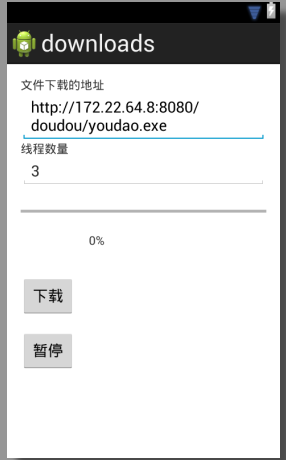
最後要注意的是別忘了在項目清單文件中加入權限:
<!-- SDCard權限 --> <uses-permission android:name="android.permission.MOUNT_UNMOUNT_FILESYSTEMS" /> <uses-permission android:name="android.permission.WRITE_EXTERNAL_STORAGE" /> <!-- 訪問網絡的權限 --> <uses-permission android:name="android.permission.INTERNET" />
希望本文所述對大家Android程序設計有所幫助。
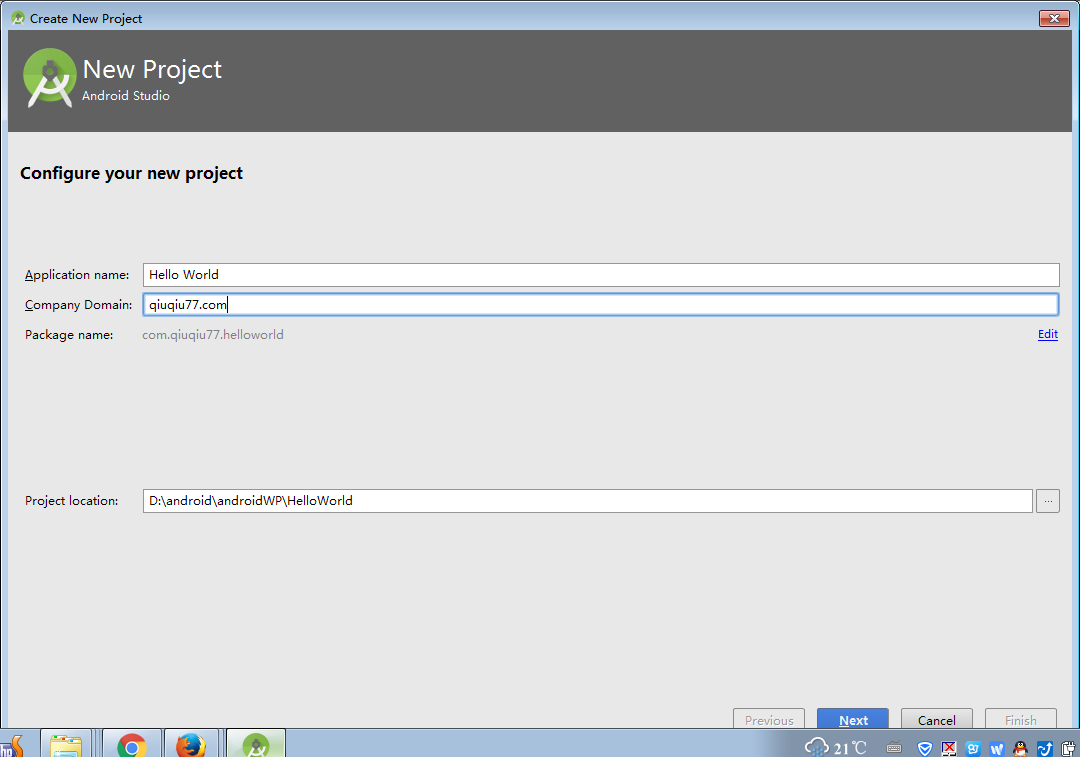 android studio教程-創建第一個項目Hello World
android studio教程-創建第一個項目Hello World
第一步,打開android studio輸入你的項目名稱“Hello World”.“Company Domian”:暫時
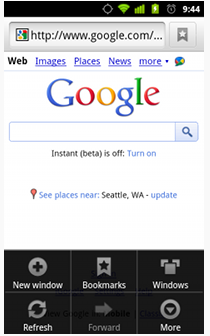 Android學習筆記——Menu介紹(一)
Android學習筆記——Menu介紹(一)
背景:Android3.0(API level 11)開始,Android設備不再需要專門的菜單鍵。隨著這種變化,Android app應該取消對傳統6項菜單的依賴。取而
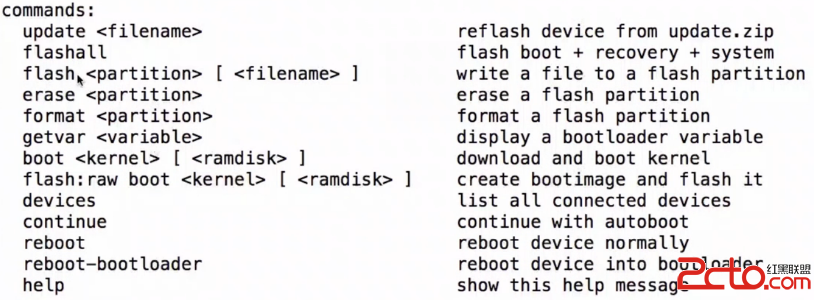 Android Root原理初探
Android Root原理初探
RootLinux:Root == Windows:AdminstratorAndroid是Linux系統嗎?操作系統 = 系統內核 + 文件系統Linux發行版:Lin
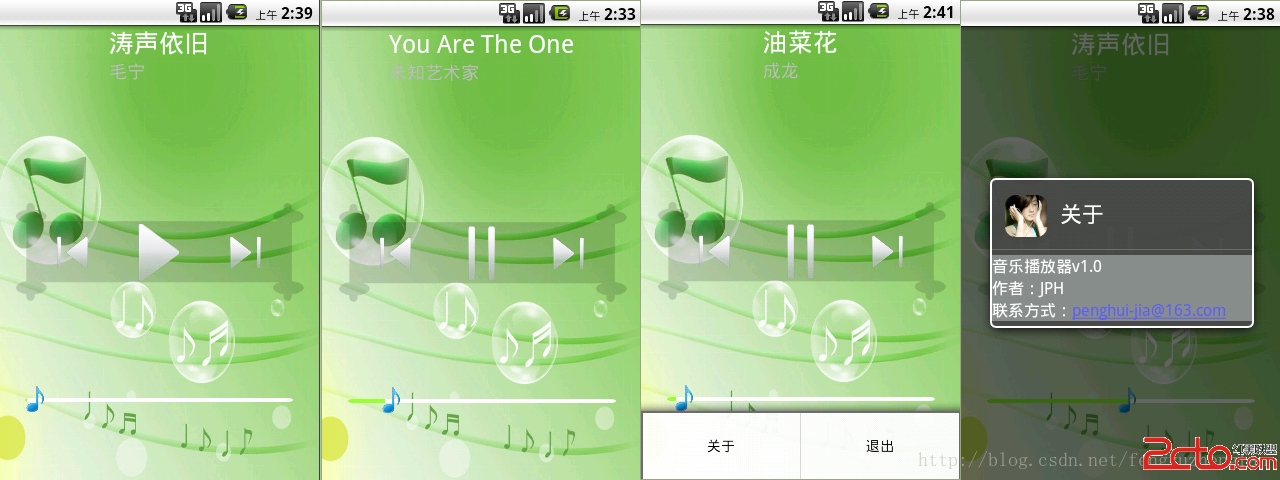 Android開發之基於Service的音樂播放器
Android開發之基於Service的音樂播放器
這是一個基於Service組件的音樂播放器,程序的音樂將會由後台的Service組件負責播放,當後台的播放狀態改變時,程序將會通過發送廣播通知前台Activity更新界面